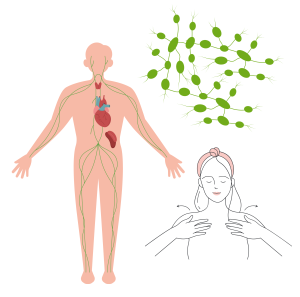Lymphatic System
Lymphatic System

Learning Objectives
- Identify the major components of the lymphatic system, including lymph nodes, lymph vessels, and lymphoid organs (such as the spleen and thymus).
- Describe the structure and function of lymphatic tissues and cells, including lymphocytes and macrophages.
- Understand the pathways of lymph flow and the relationship between the lymphatic system and the circulatory system.
- Explain the role of the lymphatic system in maintaining fluid balance, immune response, and lipid absorption from the digestive tract.
- Discuss the processes of lymph filtration and the transportation of immune cells throughout the body.
- Highlight the significance of lymphatic drainage in health and disease.
- Recognize various manual lymph drainage techniques and their purpose in promoting lymph circulation and reducing edema.
- Demonstrate basic manual lymph drainage movements and sequences, observing proper body mechanics and client positioning.
- Evaluate the indications and contraindications for manual lymph drainage in different clinical scenarios.
- Integrate knowledge of lymphatic system anatomy and physiology to understand the impact of dysfunction on overall health.
- Assess the efficacy of manual lymph drainage techniques in therapeutic settings and develop a personalized treatment approach.
